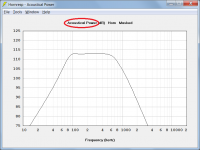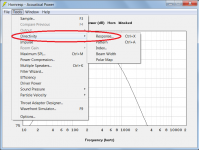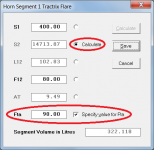Hi Cyberkul,
The chart title was changed from "SPL Response - Constant Directivity" to "Acoustical Power" some time ago, to make it more clear that it is the power response being shown, not the pressure response. If required, the Directivity > Response tool can be used to calculate the pressure response of a single-segment horn.
No, the "SPL Response - Constant Directivity" and "Acoustical Power" chart results are the same.
Kind regards,
David
I notice that many published output charts are labelled "SPL response". I don`t find that option in my version 48.4.
The chart title was changed from "SPL Response - Constant Directivity" to "Acoustical Power" some time ago, to make it more clear that it is the power response being shown, not the pressure response. If required, the Directivity > Response tool can be used to calculate the pressure response of a single-segment horn.
Is there any difference to this and the "Acoustical power" ?
No, the "SPL Response - Constant Directivity" and "Acoustical Power" chart results are the same.
Kind regards,
David
Attachments
The chart title was changed from "SPL Response - Constant Directivity" to "Acoustical Power" some time ago, to make it more clear that it is the power response being shown, not the pressure response. If required, the Directivity > Response tool can be used to calculate the pressure response of a single-segment horn
Thanks 🙂
Hi David,
Didn't the filter wizard tool were able to use before the "directivity response..." acoustical pressure curve as baseline some time ago or i dreamed ? (as it seem i did in thumbmail from post #6266 ...2597 post backward ^^)
Wether it were or not, should it be possible ?
Didn't the filter wizard tool were able to use before the "directivity response..." acoustical pressure curve as baseline some time ago or i dreamed ? (as it seem i did in thumbmail from post #6266 ...2597 post backward ^^)
Wether it were or not, should it be possible ?
Last edited:
Another question: I`ll try to make a Tractrix midbass horn. Very nice that the data export can be used as a cutting template. I made a small model in paper, and the pieces fitted nicely together. But I noticed that the mouth flare tangent wasn`t 90 degrees? I thought this was a feature of the Tractrix contour? I have tried different mouth/throat areas and length, and I enclose an example. Still not 90 degrees flare tangent at the mouth. What am I missing?
Attachments
Didn't the filter wizard tool were able to use before the "directivity response..." acoustical pressure curve as baseline some time ago
Hi papasteack,
Thanks for reporting this. Although the filter wizard does indeed say pressure, it actually the power response that is being shown. I will investigate.
Kind regards,
David
Still not 90 degrees flare tangent at the mouth. What am I missing?
Hi Cyberkul,
Using your throat area of 400 cm^2 and cutoff frequency of 80 Hz, the fully-formed tractrix horn would need to have a mouth area of 14713.87 cm^2 and an axial length of 102.83 cm.
The easiest way to design a 90-degree tractrix horn is to use the Horn Segment Wizard, as shown in Attachment 1.
Kind regards,
David
Attachments
Correction
it IS actually the power response that is being shown.
Hi Cyberkul,
Using your throat area of 400 cm^2 and cutoff frequency of 80 Hz, the fully-formed tractrix horn would need to have a mouth area of 14713.87 cm^2 and an axial length of 102.83 cm.
The easiest way to design a 90-degree tractrix horn is to use the Horn Segment Wizard, as shown in Attachment 1.
Kind regards,
David
Excellent, thanks 🙂 Back to the drawing board, then out to the garage to do some cutting.
then out to the garage to do some cutting.
Watch out for your fingers 🙂.
I will. But it seems that a full Tractrix has too big mouth area, except if I sacrifice much low extension. Could have accepted a longer L12, but that doesn`t seem to help. Grr.., physics is against me.
But it seems that a full Tractrix has too big mouth area, except if I sacrifice much low extension. Could have accepted a longer L12, but that doesn`t seem to help.
The mouth area of a fully-formed tractrix horn is determined by the horn cutoff frequency, not the horn length.
S2 = Pi * (c / (2 * Pi * F12)) ^ 2
Where c = 34400 cm /sec
If F12 = 80 Hz then S2 = 14713.87 cm^2
The tractrix profile is more suited to mid-range horns (although if I were building a mid-range horn, I would probably use a Le Cléac'h profile instead).
Question...what does the driver offset function in the wizards do?
It shifts the driver from the end of the chamber to part-way along the chamber.
It is really no different to how a driver can be offset in a transmission line loudspeaker (for example).
I will investigate.
Major changes were made in Version 42.10 to fully integrate the filter wizard tool into Hornresp. For operational reasons the ability to apply the filter to a pressure response was removed at that time, but I forgot to update the output drop-down list entry.
Rather than now just fixing the issue by changing the list entry from 'Pressure' to 'Power', after looking into the matter further I think that with a bit of work it should be possible to make the filter wizard also operate with pressure responses.
If all goes according to plan, the change will be implemented in the next release.
Major changes were made in Version 42.10 to fully integrate the filter wizard tool into Hornresp. For operational reasons the ability to apply the filter to a pressure response was removed at that time, but I forgot to update the output drop-down list entry.
Rather than now just fixing the issue by changing the list entry from 'Pressure' to 'Power', after looking into the matter further I think that with a bit of work it should be possible to make the filter wizard also operate with pressure responses.
If all goes according to plan, the change will be implemented in the next release.
Now that sounds like a wee bit of coding!
Going to be interesting David. Thanks for your hard work.
P.S. They let me back into Canada!😉
Hi 👋 Mark,
good responce!
I’ve only been doing the same since the early eighties and should probably confess to being well ‘crashed and burned’ by now...
Sad to have missed making Your aquatance at Mandy and Philip’s LSS-Loudspeaker Sourcing Show in Nansha, deeper GZ!
I have ‘operated’ (mainly quietly Ie. ‘below the Radar’) for various Clients (local and further) in the same area for the last +7 years.
With best regards
‘a1greatdane’
I'll be there next year to!
You missed my presentation on Open Source High Level loudspeaker design and simulation. And a great three days of meetings and discussions with a whole bunch of interesting people.
I need it to cover up to about 650Hz, and read positive things about the low colorations of the Tractrix. So far never heard one, so could be that a expo/hypex would serve me equally well.The tractrix profile is more suited to mid-range horns (although if I were building a mid-range horn, I would probably use a Le Cléac'h profile instead).
I'll give you my two cents worth of advice. Go with a LeCleach profile. Has the best balance of benefits.
- Home
- Loudspeakers
- Subwoofers
- Hornresp






